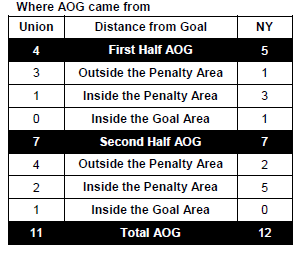Photo: Nicolae Stoian
Editors note: Since this post was originally published, the match statistics on the MLS website have been updated to reflect the awarding of the NY goal to Dane Richards rather than a Philadelphia own goal, as it was originally recorded. Also updated on the league site are open play crosses, duels won/duels won percentage and passing accuracy. The text and charts below have been updated to reflect these changes.
 If you can avert your eyes from such piddling statistics as the number of goals, shots on goal and possession, there appears to be much parity to be found in the match statistics. Attempts on goal, blocked shots, corner kicks, fouls, duels won/duels won percentage and passing accuracy all show little or no significant difference between the two sides.
If you can avert your eyes from such piddling statistics as the number of goals, shots on goal and possession, there appears to be much parity to be found in the match statistics. Attempts on goal, blocked shots, corner kicks, fouls, duels won/duels won percentage and passing accuracy all show little or no significant difference between the two sides.
The Union had a slight advantage in passing accuracy, impressive perhaps in view of the fact that they attempted 71 more passes than New York. (Or was it 82 more? Longtime readers of these stat chats will remember that the number of passes and passing accuracy numbers found in the match statistics tab can differ greatly from those found through the chalkboard tab. For this game, the Chalkboard tab has the Union with a total of 512 passes and New York with 430 compared to 461 for the Union and 390 for New York at the Stats tab.)
More difference begins to emerge
New York had one more attempt on goal in the first half than the Union. In the second half, each team had seven attempts on goal. But New York recorded significantly more shots on target, with three in the first half and two in the second half. The Union’s lone shot on goal came in the first half, a harmless effort from Zach Pfeffer. Overall, this translates into a shots on goal percentage of 42 percent for New York compared to nine percent for the Union.
Looking more deeply at the attempts on goal, it can be argued that New York produced higher quality attempts to score, with three long-range efforts from outside the penalty area, eight attempts from within the penalty area, and one from the goal area. In comparison, the Union had seven long-range attempts, three from within the penalty area and one from inside the goal area.
Another difference begins to emerge when we look more deeply at open play crosses. On the surface, the match stats suggest a parity with each team recording eleven. But when we go deeper into this statistic using the Chalkboard, we find that not one of the Union’s 11 open play crosses was successfully completed. New York, on the other hand, completed five of the 11 they attempted, a success rate of 45 percent. One of those successful open play crosses resulted in the game’s only goal. (As of the writing of this updated version of the post, the Chalkboard still shows New York as having 12 open play crosses while the match statistics tab now shows 11.)
The final third
The Union’s overall passing accuracy of 77 percent surpassed New York’s 76 percent. That advantage was present in the first third of the pitch (75 percent vs. 73 percent) and in the middle (79 percent vs. 78 percent). But when we look at passing accuracy in the final third the Union’s advantage disappears: while the Union completed 51 percent of their passes in the final third, New York was far better at 62 percent.
To illustrate the advantage enjoyed by New York, consider this. In the first half, the Union did not complete a single pass in the final third until the 16th minute, and that was a throw-in to Sebastien Le Toux. Le Toux would complete the Union’s first successful footed pass of the game from that throw in to Zach Pfeffer, who was promptly dispossessed of the ball. During that stretch, New York recorded three successful passes, including the cross that led to their eight minute goal. The Union’s next successful footed pass wouldn’t come until the 31st minute, a cross from a free kick by Justin Mapp. In that period, New York recorded an additional ten successful passes in the final third.
The numbers compared to previous eight games
The Union’s recent winless streak was snapped with the 1–0 win over Columbus at PPL Park on September 17. The unbeaten streak that began with the 4–4 draw against New England on September 10 ended at eight games with the loss in New York.
 Comparing the Union’s numbers at New York to the averages for the previous eight games of the unbeaten streak, we find that their performance was below par in every major offensive category, including goals, attempts on goal, shots on goal, shots on goal percentage and goal percentage. Meanwhile, New York recorded better numbers than the averages for the Union’s opponents in every category except for goals and goal percentage. But, when you score one goal and the other team scores none, that kind of shortfall will be happily taken.
Comparing the Union’s numbers at New York to the averages for the previous eight games of the unbeaten streak, we find that their performance was below par in every major offensive category, including goals, attempts on goal, shots on goal, shots on goal percentage and goal percentage. Meanwhile, New York recorded better numbers than the averages for the Union’s opponents in every category except for goals and goal percentage. But, when you score one goal and the other team scores none, that kind of shortfall will be happily taken.


I knew NY had alot of shots, but 111.. Damn.
Corrected. Yep, I worked 14 hours on Friday after traveling to RBA on Thursday. Can you tell?
Also we had 54% possession but still got edged in that category.
Holy Christmas, it appears I was having the kind of night when I wrote this that the Union had on Thursday!
In double checking the numbers on the chart, I saw that the match statistics on the MLS site have been updated. The post has been edited to reflect those changes.